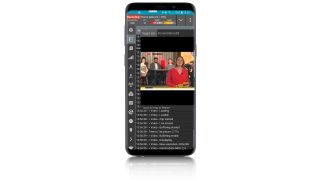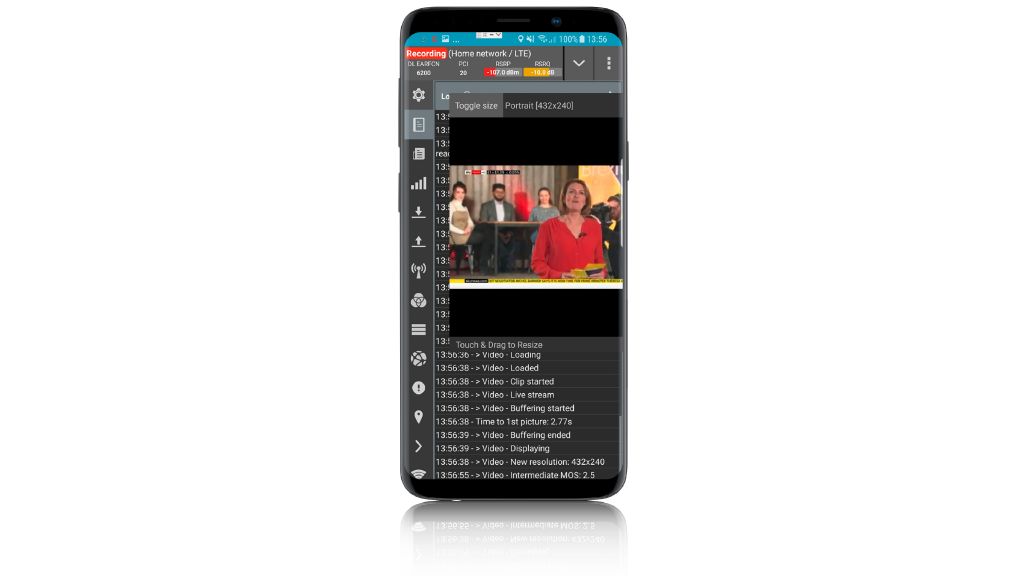Video quality testing in mobile networks
This application card examines the best practices for testing video service quality over mobile networks and discusses the different types of video services and recent changes in video streaming.

This application card examines the best practices for testing video service quality over mobile networks and discusses the different types of video services and recent changes in video streaming.
Your task
Video services take up the biggest chunk of data in today’s mobile networks and their share of data consumption will only increase. New services for XR and VR applications will use similar transmission techniques and consume even more data. Resolution is increasing in line with transport capacity and high-resolution screens on smartphones are making user expectations ever more demanding. Video service quality has a big impact on customer satisfaction. The decision to deliver higher or lower resolution and quality may considerably influence mobile network operator (MNO) infrastructure because of the huge amounts of data that are transmitted.
Waiting time (time to first picture), image quality and the fluidity of video play out (no freezing, sufficient frame rate) determine end user satisfaction. Video content providers are constantly adapting compression, delivery and video buffering to cope with imperfect networks, potential outages, bottlenecks and to find the best trade-off between these quality of experience (QoE) factors.
Video transmission is not always a continuous stream. Streaming from a common platform is more like a series of file downloads. Because parts of a video are stored in the buffer, there are always times when a mobile network is not transmitting. Chunk-wise, file-like downloads help mask many potential problems in the network, smooth over and bridge outages and capacity degradation. If an MNO cannot get information about these problems, they would remain invisible.
The client-to-server adaptation has some leeway when reacting to network issues with file-like downloading and buffering. Real-time live videos have far fewer options. Live TV streaming uses a short delay and the video can only be buffered for a few seconds on the device. Frequent and almost continuous data transmissions are required. Since the buffer can only bridge small outages, there is a higher risk of the video freezing up. Network performance can be monitored almost seamlessly because there is more activity on the network.
Network resource usage varies depending on the video delivery method. All video services have the video client (on the smartphone) request and receive encoded video information from a content server, usually a third party outside the MNO network. For non real-time services, a video is pre-buffered for a few seconds before the video starts. Realtime services cannot pre-buffer, they usually start playing at the next synch frame. There are different strategies for transmitting a video file to the smartphone buffer:
Non real-time streaming is still dominant. However, realtime ervices are on the rise, such as remote controls with visual feedback, surveillance services and others. Realtime transmission must be seamless, even the shortest interruptions or delays can be seen. Video services already place great demands on networks but real-time services will be critical.


Graphical user interface of the video quality test in QualiPoc Android
Rohde & Schwarz solution
Measuring key technical features such as resolution, frame rate, bit rate estimation and freeze counts are vital. Ultimately these features determine the perceived quality for the user. Video compression is highly scalable and based on algorithms and settings. Image quality can differ for the same resolution and bit rate. An integrative, perception based measurement most reliably illustrates the effects of compression and resolution degradation, including jerky video displays and freezing of the video. These factors are combined in a single score. The perceived video quality measurements should be based on direct image analysis, generating a mean opinion score (MOS) for a video that relates to real user perceptions of quality.
The mean opinion score (MOS) is a widely accepted and standardized method for measuring and predicting perceived video quality. The ITU-T approved the TU-T J.343.1 method developed by Rohde & Schwarz SwissQual AG. The method analyzes the actual received video information and displayed images to predict the visual quality as perceived by an average human viewer. Like a human viewer, the algorithm just examines the received video. Because there is no need for a comparison to a reference source video, it can also be used for live video and applied to all current mobile video streaming services, even the streaming of encrypted content. J.343.1 in ETSI TS 102 250-2 recommends visual quality measurements for all mobile video services.
This new video quality algorithm is made for smartphones, is fully implemented under Android and is supported by all Rohde & Schwarz mobile network testing products. Rohde & Schwarz testing product range includes everything from the handheld QualiPoc Android to the largescale Benchmarker3. The lean QualiPoc can score arriving videos in real time, including live video (the most critical test case for mobile networks). Video quality evaluations are embedded in a fully automated test solution for video services with a comprehensive set of technical parameters and KPIs. The entry-level version of Rohde & Schwarz products can evaluate YouTube videos and is ideal for covering the variable bit rates and resolutions currently used by the platform.
Rohde & Schwarz video quality test solutions let mobile network operators verify whether popular video applications run well on their networks. Since video service performance is essential to customer satisfaction, mobile network operators will have more satisfied subscribers, lower churn rates and be able to lure away customers from the competition thanks to proper testing solutions.
When measuring a video streaming service, all parts of the transmission chain are analyzed, from the content servers to user devices and software clients on user devices. Mobile network performance itself is only one factor.
Additional information
For more information on the test and measurement solutions and products (such as QualiPoc Android and related products such as R&S®FR4 Freerider 4 backpack system and Benchmarker3), contact your Rohde & Schwarz sales office or visit www.rohde-schwarz.com.